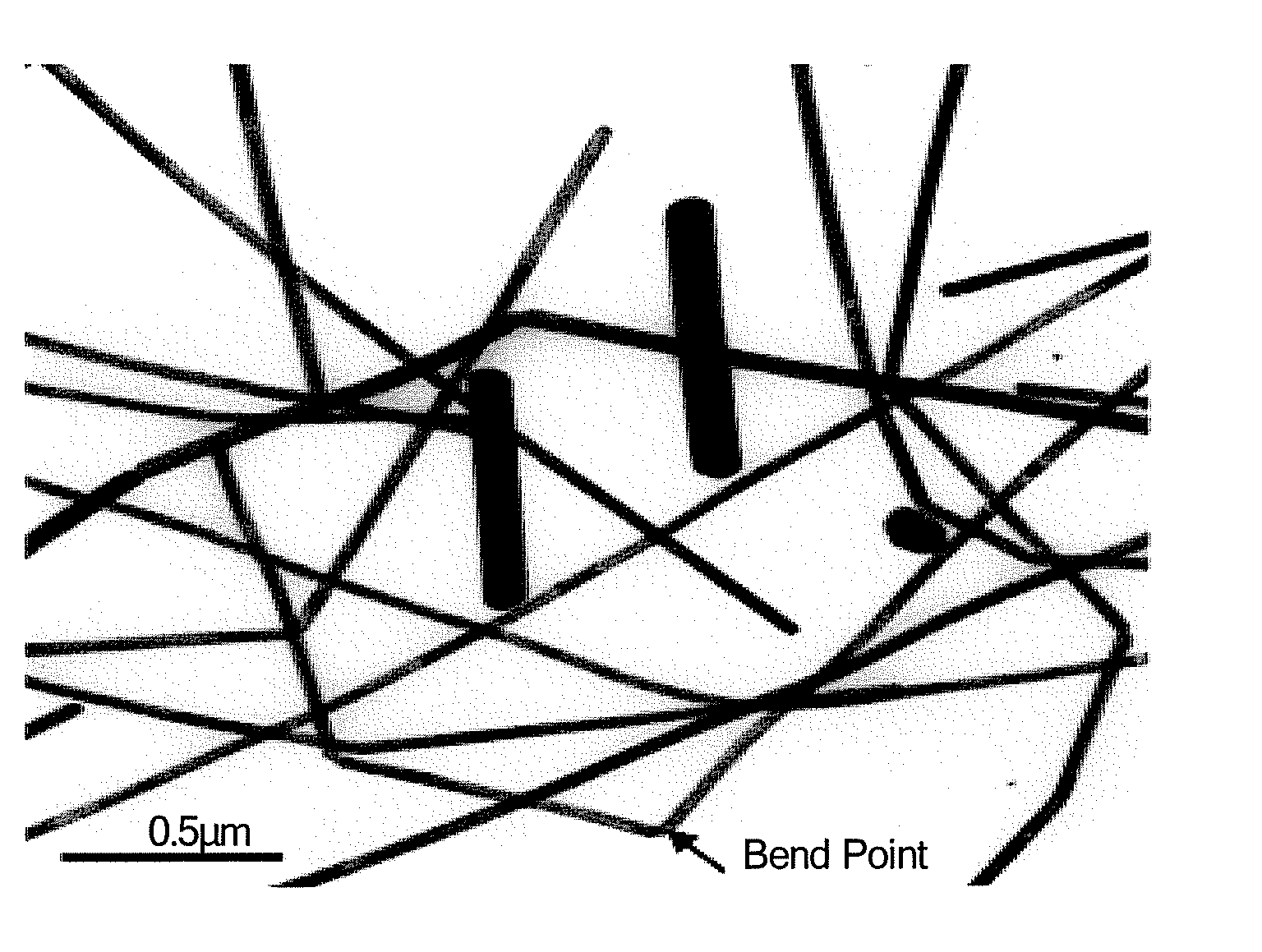Bent rod-shaped metal particles, manufacturing method for the same, composition containing the same, and conductive material
a technology of metal particles and manufacturing methods, which is applied in the direction of non-conductive materials with dispersed conductive materials, thin material processing, transportation and packaging, etc., can solve the problems of reducing the surface resistance of the base and the difficulty of linear metal nanowires to form such a conductive network, and achieve excellent conductivity and low surface resistance. , the effect of high optical transmittan
- Summary
- Abstract
- Description
- Claims
- Application Information
AI Technical Summary
Benefits of technology
Problems solved by technology
Method used
Image
Examples
example 1
Preparation of Bent Rod-Shaped Silver Particles
[0084]Ethylene glycol (10 ml) was added in a three-necked flask equipped with a reflux tube. After purging the flask with nitrogen gas for 5 minutes, ethylene glycol was refluxed for 2 hours at 160° C. To the flask was added 3 ml of 0.1 mM tetrachloroaurate hexahydrate in ethylene glycol, heated at 160° C. for 5 minutes, and stirred. Additionally, 10 ml of an ethylene glycol solution containing 50 mM silver nitrate (Kanto Chemical Co., Ltd.) and 200 mM polyvinylpyrrolidone (weight−average molecular weight=360,000) was added to the reaction solution over 20 minutes. The reaction solution was heated at 160° C. for 60 minutes and stirred. After confirming the formation of rod-shaped silver particles, the solution was further heated at 180° C. for 60 minutes and stirred. The reaction solution was cooled to room temperature, and 5 volumes of acetone was added for aggregation of the resultant product. The aggregate was then dispersed in 10 ml...
example 2
Fabrication of Conductive Film
[0087]A 1.5 wt % polyvinyl alcohol (PVA) aqueous solution was applied onto a 100 μm-thick polyethylene terephthalate (PET) base using a #10 coat bar, and dried at 60° C. for 5 minutes to form a undercoat layer.
[0088]The dispersion prepared in Example 1 (0.3 wt %) was then applied onto the PVA coat of the PET base using the #10 bar, and dried at 60° C. for 5 minutes to form is a bent rod-shaped silver particle-containing layer, which was then subjected to annealing treatment at 120° C. for 5 minutes to enhance conductivity.
[0089]Subsequently, 1.0 wt. % PVA in methyl ethyl ketone was applied onto the bent rod-shaped silver particle-containing layer of the PET base using the #10 bar, and dried at 60° C. for 5 minutes to form an overcoat layer. In this way a conductive film containing bent rod-shaped silver particles was fabricated.
[0090]The conductive film had a surface resistance of 101-102 Ω / sq. as measured by the four-probe method. The conductive film h...
example 3
Preparation of Bent Rod-Shaped Silver Particles
[0091]Bent rod-shaped silver particles of Example 3 were prepared as in Example 1 except that the reflow temperature, reaction temperature after addition of 3 ml of 0.1 mM tetrachloroaurate hexahydrate in ethylene glycol, and reaction temperature after addition of 10 ml of an ethylene glycol solution containing 50 mM silver nitrate (Kanto Chemical Co., Ltd.) and 200 mM polyvinylpyrrolidone (weight-average molecular weight=360,000) were all set to 180° C.
[0092]As in Example 1, transmission electron microscopy of the dispersion demonstrated the presence of bent rod-shaped silver particles formed by bonding together of linear silver particles at their ends, as shown in FIG. 6 (the scale bar in the drawing is 2 μm in length).
[0093]The average bend angle of the bend points, as measured by TEM, was 90°. The minor-axis length and aspect ratio of the bent rod-shaped silver particles, as measured by TEM, were 36 nm and 110 respectively.
PUM
| Property | Measurement | Unit |
|---|---|---|
| bend angle | aaaaa | aaaaa |
| length | aaaaa | aaaaa |
| aspect ratio | aaaaa | aaaaa |
Abstract
Description
Claims
Application Information
 Login to View More
Login to View More - R&D
- Intellectual Property
- Life Sciences
- Materials
- Tech Scout
- Unparalleled Data Quality
- Higher Quality Content
- 60% Fewer Hallucinations
Browse by: Latest US Patents, China's latest patents, Technical Efficacy Thesaurus, Application Domain, Technology Topic, Popular Technical Reports.
© 2025 PatSnap. All rights reserved.Legal|Privacy policy|Modern Slavery Act Transparency Statement|Sitemap|About US| Contact US: help@patsnap.com



